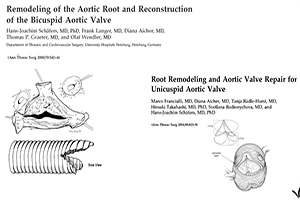Remodeling of the aortic root—a 28-year journey
Abstract
Background: Root remodeling is one form of valve-preserving root replacement for aortic regurgitation and root aneurysm. The objective of this review was to summarize our experience with root remodeling encompassing 28 years.
Methods: We performed root remodeling in 1,189 patients (76% male, mean age 53±14 years) between October 1995 and September 2022. The original valve morphology was unicuspid in 33 (2%), bicuspid in 472 (40%) and tricuspid in 684 (58%) patients. Fifty-four patients (5%) had Marfan’s syndrome. Objective measurement of valve configuration was performed in 804 (77%) and an external suture annuloplasty was added in 524 patients (44%). Cusp repair was performed in 1,047 (88%) patients, most commonly for prolapse (n=972; 82%). Mean follow-up was 6.7±5.5 years [1 month to 28 years]. Follow-up was 95% complete (7,700 patient-years).
Results: Survival was 71% at 20 years; freedom from cardiac death was 80%. Freedom from aortic regurgitation ≥2 was 77% at 15 years. Freedom from reoperation was 89% and was higher in tricuspid aortic valves (94%) compared to bicuspid (84%) and unicuspid valves (P<0.001). Since the introduction of effective height measurement, freedom from reoperation has remained stable at 15 years (91%). With the addition of a suture annuloplasty, freedom from reoperation was 94% at 12 years. The difference with or without annuloplasty (91%) was not significant (P=0.949).
Conclusions: Root remodeling is a viable option in valve-preserving root replacement. Concomitant cusp prolapse is frequent and can be corrected reproducibly by intraoperative measurement of effective height. The long-term benefit of an annuloplasty still needs to be defined.
Cover






